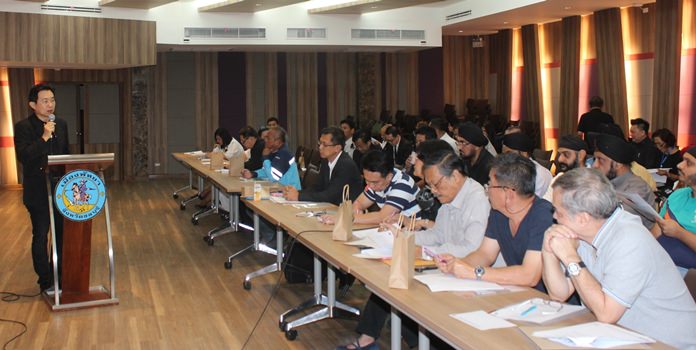
Walking Street property owners again have successfully thwarted – at least for now – any move to demolish up to half of the nightlife district due to public-land encroachment, a battle that has been raging for 20 years.
At the second public hearing on the 1.5-billion-baht proposal to redevelop the waterfront side of Walking Street into a public park, property owners presented rafts of documents they claim are legal property and land deeds and demanded their authenticity be investigated before any further action on the redevelopment plan occurs.
Those same demands and investigations have been made repeatedly over the past two decades with no resolution and, hence, no impact on Walking Street.
As early as 1988, 101 structures were deemed to be encroaching on public land and targeted for demolition. But the impact on tourism that demolishing so many of the bars and restaurants would have repeatedly has scuttled any action.
A royal decree on land expropriation issued April 17, 2014 confirmed the findings of the 1998 Japan International Cooperation Agency report. But owners of those properties, including some of Pattaya’s wealthiest and politically connected families, stalled any move to demolish the buildings even as Walking Street grew into Pattaya’s best-known and most-lucrative tourist attraction.
Silapakorn University was hired in May to begin work on a redevelopment plan which included an examination of all the infringing structures’ documents and the determination that a majority of them were not properly registered.
Four options were suggested at the first hearing Oct. 6, three of which were viewed as “nuclear” choices, basically calling for the waterfront side of the popular nightlife strip to be leveled and rebuilt.
Option 1 reiterated the 1988 finding that the waterfront side of Walking Street be demolished and turned into a public park and marina using a 1.5-billion-baht budget.
Option 3 and 4 were similar in also calling for all encroaching structures to be removed, but with differing development plans of 1 billion baht and 500 million baht, respectively.
Only Option 2 – removing only those structures extending 40 meters from Walking Street onto public land – gained even a smidgen of support.
Those attending the first hearing and others expressing their views in the weeks since said they don’t want any redevelopment done, but if something must happen, Option 2 was the only acceptable choice.
Meeting chairman Suntorn Sompramai, acting head of the Engineer Department, said that the documents would need to be examined and investigated and all other issues would have to wait until that was complete.
No timeline or estimate was given as to how long that might take. It’s a situation that has been repeated time and again.
In May 2015, then-Deputy Mayor Ronakit Ekasingh said 12 Walking Street buildings had been ordered demolished for illegally extending their property. The property owners were given a chance to appeal and only a small number of extensions were demolished.
Despite the apparent death knell for the redevelopment plan, head of the Silapakorn consulting team, Thana Jirapiwat, said his group would continue studying other possible ways of redevelopment that will have minor effects on existing facilities and businesses.
Any options they come up with would be discussed at some meeting in the unspecified future.
Fast Forward to June 11, 2020. Read the latest story.




